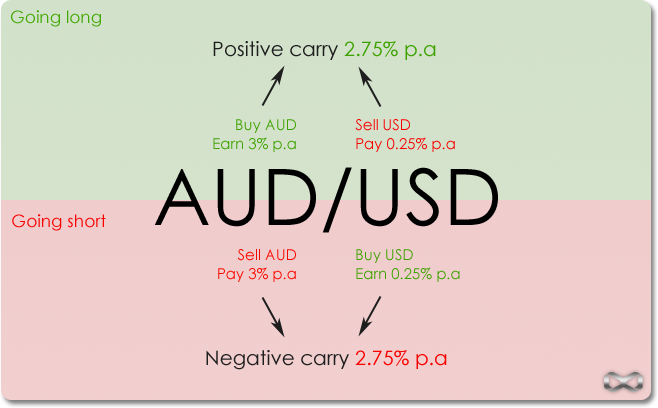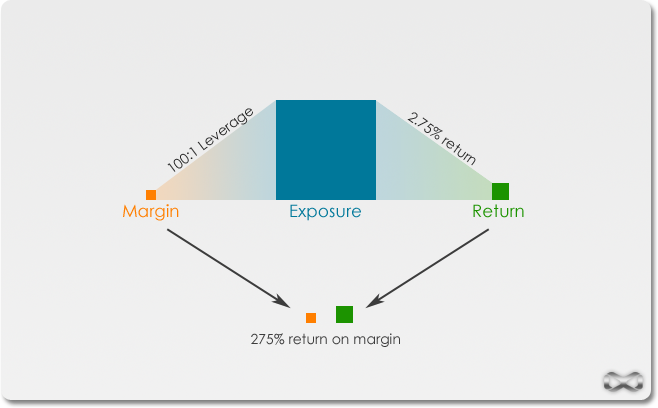An Alternative Way to Make Money in Forex
Most new forex traders are familiar with the concept of buying low and selling high (going long) and also the concept of selling high and buying low (going short)… but there is another powerful means by which professional currency traders make money.
It’s called Positive Carry.
Positive carry occurs when a trader is short on a currency with a relatively low interest rate while being simultaneously long on another currency that yeilds a relatively high interest rate.
A trader using this strategy will capture the difference between the rates, which can add up if that interest rate differential (IRD) is large enough. “Carry” is sometimes shown on your brokerage platform under a column called “rollover”. All trades are susceptible to rollover and no extra step is required to harness the advantage (or disadvantage) of it.
Rollover is the interest paid or earned for holding a position overnight (at 5PM New York EST). Each currency has an interest rate associated with it, and because forex is traded in pairs, every trade involves not only two different currencies, but their two individual interest rates as well. If the interest rate of the currency you bought is higher than the interest rate of the currency you sold, then you will earn rollover (positive carry). But if the interest rate on the currency you bought is lower than the interest rate on the currency you sold, then you will pay rollover (negative carry).
For Example
When you buy the AUDUSD pair for example, you are buying the Australian dollar, and selling the US dollar. If the Australian interest rate is 3%, and the US rate is 0.25%, you are buying the currency with the higher interest rate, and you will earn rollover (2.75% on an annual basis). The 2.75% annual interest rate is calculated by earning 3% from buying AUD, and subtracting the 0.25% you must pay for selling USD.
If the Australian interest rate is 3%, and the US rate is 0.25%, you are buying the currency with the higher interest rate, and you will earn rollover (2.75% on an annual basis). The 2.75% annual interest rate is calculated by earning 3% from buying AUD, and subtracting the 0.25% you must pay for selling USD.

If you short the AUDUSD pair, you are selling the currency with the higher interest rate, and you will pay rollover, since you are paying the (high) Australian interest rate and earning only the (low) US interest rate.
Considering global interest rates at the time of writing this, going long AUDUSD is a positive carry trade, whereas going short AUDUSD is a negative carry trade. To keep an eye on global interest rates, keep
To keep an eye on global interest rates, keep this page in your bookmarks.
But wait… I’m a trader! 2.75% per annum is nothing, right? I hope that’s what you were thinking. There is, however, one important element I am yet to mention.
Leverage.
Believe it or not, the 2.75% is actually paid on the entire market exposure of the position, not just the margin you put up to place the trade. To explain this with an example, I currently trade 100:1 leverage in my account. This means for every $1,000 margin I put up, I have $100,000 of exposure in the market.
At 2.75% per year, I will bank $2,750 in interest just by holding AUDUSD long for a year! This is 275% profit on my margin. To calculate how much interest you will make on your margin, simply multiply the interest rate by your leverage ratio. At 50:1 leverage in the example above, your interest rate will be 137.5% per year on your margin (2.75*50).

In the right market conditions, positive carry is actually very powerful when you apply it with the correct analysis and risk management.
So you might be thinking…
If I can bank 140% interest from doing pretty much nothing, why should I bother swing trading and day trading?
Remember, Carry trading is still far from being risk free!
Also, you need to keep in mind that this is still just 140% on your margin, and not on your entire account. You should never engage your entire account in any given carry trade, since you could easily blow the whole lot (very quickly) when trading high degrees of leverage. To bank the interest differential, the trade needs to remain running. This means you are subject to market fluctuations that may cause losses on the actual position (despite profiting from rollover).
A stop loss is still essential when trading positive carry positions, but the aim of the game here is to give price plenty of breathing room. Remember, even if the market goes sideways for two years, you still bank your rollover each and every night, despite the fact that you may only break even on the trade itself. The longer the trade runs, the more interest you stand to make. This is why we use the weekly charts to analyze entries, since they give the best indication of long-term support/resistance and direction.
3 Tips for Trading Positive Carry
- Make sure your analysis is on a pair with positive carry and in the direction of the positive carry.
- Use a weekly (or monthly) chart for your analysis. Dailies simply won’t provide a big enough picture.
- Target historical highs and lows for higher probability entry zones.
- Set a stop loss below key support when going long, or above key resistance when going short. Protect it from being hit for as long as possible.
- Trade size to 3% maximum account risk.
The reasons we can afford to risk up to 3% on these trades are as follows:
- Set ups are very rare compared to regular swing trading.
- The probability of generating profit on each trade is higher since we make a healthy interest return if the market moves sideways, and a fantastic capital gain if the market moves in the direction of our trade.
- Since trades run longer, they tend to move further and therefore offer a much higher reward risk ratio than regular swing trading.



Leave a Comment